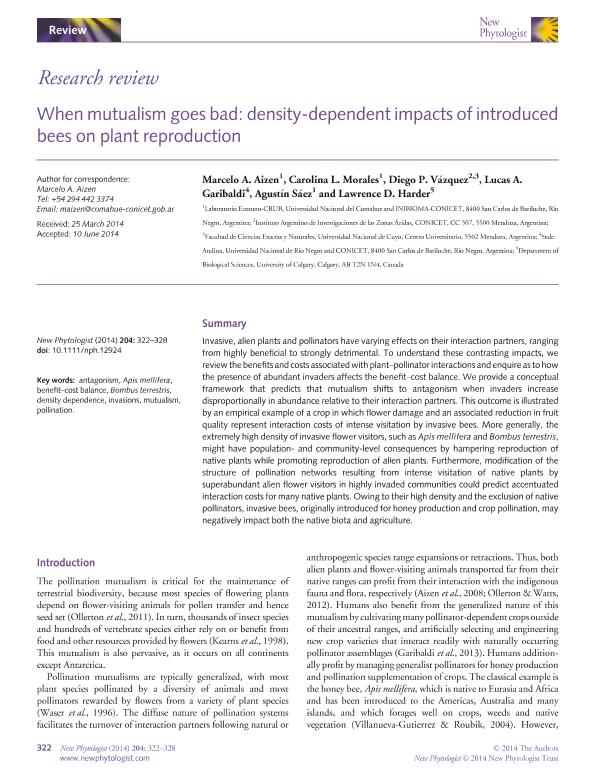Mostrar el registro sencillo del ítem
dc.contributor.author
Aizen, Marcelo Adrian

dc.contributor.author
Morales, Carolina Laura

dc.contributor.author
Vazquez, Diego P.

dc.contributor.author
Garibaldi, Lucas Alejandro

dc.contributor.author
Sáez, Agustín

dc.contributor.author
Harder, Lawrence D.
dc.date.available
2017-01-27T21:10:03Z
dc.date.issued
2014-06
dc.identifier.citation
Aizen, Marcelo Adrian; Morales, Carolina Laura; Vazquez, Diego P.; Garibaldi, Lucas Alejandro; Sáez, Agustín; et al.; When mutualism goes bad: density-dependent impacts of introduced bees on plant reproduction; Wiley; New Phytologist; 204; 2; 6-2014; 322–328
dc.identifier.issn
0028-646X
dc.identifier.uri
http://hdl.handle.net/11336/12136
dc.description.abstract
Invasive, alien plants and pollinators have varying effects on their interaction partners, ranging from highly beneficial to strongly detrimental. To understand these contrasting impacts, we review the benefits and costs associated with plant–pollinator interactions and enquire as to how the presence of abundant invaders affects the benefit–cost balance. We provide a conceptual framework that predicts that mutualism shifts to antagonism when invaders increase disproportionally in abundance relative to their interaction partners. This outcome is illustrated by an empirical example of a crop in which flower damage and an associated reduction in fruit quality represent interaction costs of intense visitation by invasive bees. More generally, the extremely high density of invasive flower visitors, such as Apis mellifera and Bombus terrestris, might have population- and community-level consequences by hampering reproduction of native plants while promoting reproduction of alien plants. Furthermore, modification of the structure of pollination networks resulting from intense visitation of native plants by superabundant alien flower visitors in highly invaded communities could predict accentuated interaction costs for many native plants. Owing to their high density and the exclusion of native pollinators, invasive bees, originally introduced for honey production and crop pollination, may negatively impact both the native biota and agriculture.
dc.format
application/pdf
dc.language.iso
eng
dc.publisher
Wiley

dc.rights
info:eu-repo/semantics/openAccess
dc.rights.uri
https://creativecommons.org/licenses/by-nc-sa/2.5/ar/
dc.subject
Antagonism
dc.subject
Apis Mellifera
dc.subject
Benefit–Cost Balance
dc.subject
Bombus Terrestris
dc.subject
Density Dependence
dc.subject
Invasions
dc.subject
Mutualism
dc.subject
Pollination
dc.subject.classification
Ecología

dc.subject.classification
Ciencias Biológicas

dc.subject.classification
CIENCIAS NATURALES Y EXACTAS

dc.title
When mutualism goes bad: density-dependent impacts of introduced bees on plant reproduction
dc.type
info:eu-repo/semantics/article
dc.type
info:ar-repo/semantics/artículo
dc.type
info:eu-repo/semantics/publishedVersion
dc.date.updated
2016-12-12T14:27:41Z
dc.journal.volume
204
dc.journal.number
2
dc.journal.pagination
322–328
dc.journal.pais
Estados Unidos

dc.journal.ciudad
Hoboken
dc.description.fil
Fil: Aizen, Marcelo Adrian. Universidad Nacional del Comahue. Centro Regional Universitario Bariloche. Laboratorio de Ecotono; Argentina. Consejo Nacional de Investigaciones Científicas y Técnicas. Centro Científico Tecnológico Patagonia Norte. Instituto de Investigación en Biodiversidad y Medioambiente; Argentina
dc.description.fil
Fil: Morales, Carolina Laura. Universidad Nacional del Comahue. Centro Regional Universitario Bariloche. Laboratorio de Ecotono; Argentina. Consejo Nacional de Investigaciones Científicas y Técnicas. Centro Científico Tecnológico Patagonia Norte. Instituto de Investigación en Biodiversidad y Medioambiente; Argentina
dc.description.fil
Fil: Vazquez, Diego P.. Consejo Nacional de Investigaciones Científicas y Técnicas. Centro Científico Tecnológico Mendoza. Instituto Argentino de Investigaciones de Zonas Aridas; Argentina. Universidad Nacional de Cuyo. Facultad de Ciencias Exactas y Naturales; Argentina
dc.description.fil
Fil: Garibaldi, Lucas Alejandro. Universidad Nacional de Rio Negro; Argentina. Consejo Nacional de Investigaciones Científicas y Técnicas; Argentina
dc.description.fil
Fil: Sáez, Agustín. Universidad Nacional del Comahue. Centro Regional Universitario Bariloche. Laboratorio de Ecotono; Argentina. Consejo Nacional de Investigaciones Científicas y Técnicas. Centro Científico Tecnológico Patagonia Norte. Instituto de Investigación en Biodiversidad y Medioambiente; Argentina
dc.description.fil
Fil: Harder, Lawrence D.. University Of Calgary; Canadá
dc.journal.title
New Phytologist

dc.relation.alternativeid
info:eu-repo/semantics/altIdentifier/doi/http://dx.doi.org/10.1111/nph.12924
dc.relation.alternativeid
info:eu-repo/semantics/altIdentifier/url/http://onlinelibrary.wiley.com/doi/10.1111/nph.12924/abstract
Archivos asociados
